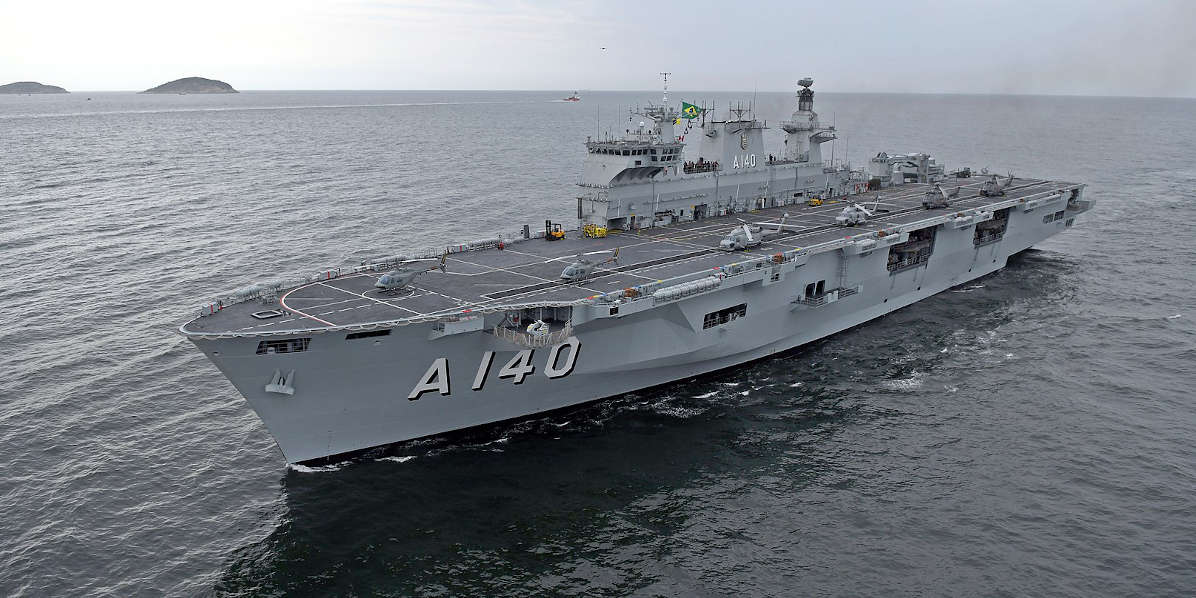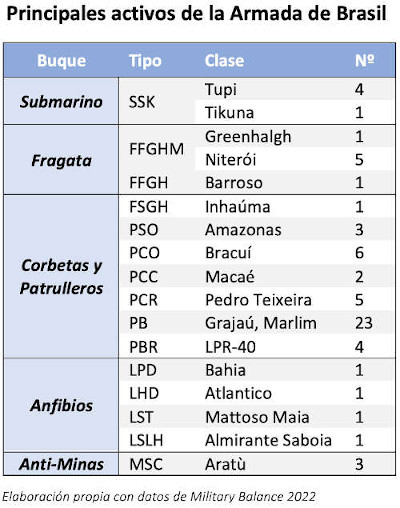In the picture
The helicopter carrier 'NAM Atlântico' [Marinha do Brasil].
report AMERICAN REGIONAL SECURITY, SRA-2023 /PDF version of article
° The exchange of an aircraft carrier, once purchased from France, for a helicopter carrier, purchased in 2018 from the United Kingdom, aligns capabilities with strategic objectives.
° The Brazilian fleet is on its way from being a "green water" fleet to a "blue water" fleet, with a permanent presence beyond its territorial waters.
° In 2022 Brazil participated in several river exercises with the navies of neighboring countries, underscoring the leadership of the largest country with the most rivers in South America.
In recent years, the Brazilian Navy (Marinha do Brasil) has shown clear ambitions to become the strongest navy in Latin America, with increased investments in its surface and submarine fleet, and a growing projection towards the South Atlantic. Traditionally considered a fleet with only coastal capabilities, Brazil has strengthened in recent years to become one of the most important in the subcontinent. Its projection capacity extends to two dimensions of naval security: maritime operations in the South Atlantic and river operations in continental waters.
This article first reviews the evolution of the Navy's assets and main units up to the present day, followed by a brief introduction to the geopolitics of the South Atlantic and its main players, and ending with the river operations that Brazil has carried out in recent years in the waters of the continent.
Marinha do Brasil
During the period between 1996 and 2005, Brazil gave up leave a total of 21 ships of its Navy, thus leaving it in a status of leave projection capacity. However, this did not prevent the Navy from taking part in different missions, highlighting the participation of four of its vessels ('Mattoso Maia', 'Almirante Gastao Motta', 'Rio de Janeiro' and 'Bosísio') in a mission statement United Nations peacekeeping mission to Haiti. This period, however, was followed by another of progressive growth and new acquisitions that gradually restored the capacity to aspire to be one of the most dominant navies of the subcontinent as it is today.
More recently, 2023 began with the intentional sinking of its only aircraft carrier, the 'CV Sao Paulo'. Out of service since 2018, the leave final of this ship that was purchased from France in 2000 was compensated with the purchase from the British Royal Navy, that same year, of the former amphibious ship (or Landing Helicopter Dock, in precise terms) 'HMS Ocean', renamed 'NAM Atlântico'. This ship, which now stands out as one of the most lucid and strongest in the Brazilian Navy with capacity for 18 helicopters, needed repairs to its hangar and flight deck, as well as upgrades to its communication systems. Now, in addition to helping to monitor national territorial waters for illegal fishing or drug trafficking, the ship will undoubtedly make the Navy more willing to participate in humanitarian missions such as the one in Lebanon.
Among the latest acquisitions for the Navy, the new frigates of the class Tamandaré, to be delivered to the Navy between 2025 and 2028, will provide the Navy with greater projection capacity in the South Atlantic. Both these and the 'NAM Atlântico' will provide Brazil with greater capabilities on its way to becoming a navy with great aspirations of projection in the South Atlantic. As Wilder Sanchez points out, "the acquisition of the Atlantic helicopter carrier, together with the ProSub submarine program and the Tamandaré corvette, are examples of the Brazilian Navy's aspirations to become a true blue water navy in the 21st century".
When it comes to differentiating between navies of different caliber, one of the most widely used classifications is that of Todd-Lindberg, which distinguishes between "blue water" and "green water" fleets, which in turn have several subcategories. The former, which includes navies of the caliber of the United States, France or China (and Spain), implies a projection capacity that goes beyond the mere defense of their territorial waters and coastline. In contrast, a green-water fleet focuses solely on the defense of its territorial waters. In the case of the Brazilian Navy, it is a green water fleet, on its way to becoming a blue water fleet through the increase and strengthening of its naval assets.
Brazil's ambitions must be understood in the geopolitical context of the Atlantic, which has been receiving increasing attention in recent years.


